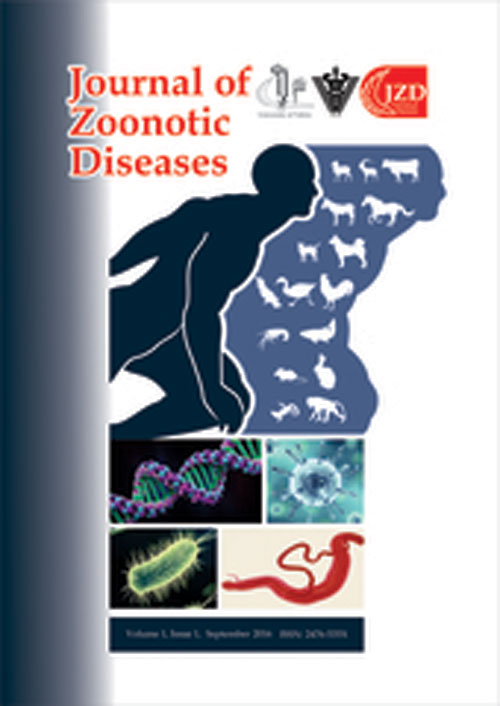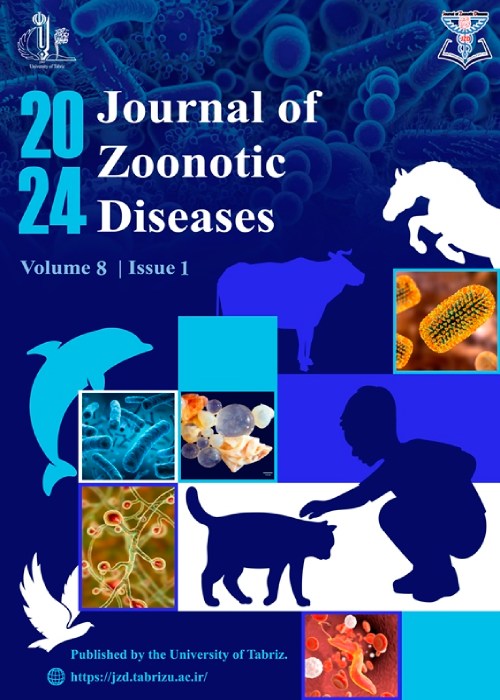فهرست مطالب

Journal of Zoonotic Diseases
Volume:4 Issue: 1, Spring 2020
- تاریخ انتشار: 1399/02/12
- تعداد عناوین: 6
-
-
Pages 1-8
The natural exposure of domestic cats to Leptospira spp. and some associated risk factors were studied in a large city from tropical Mexico. Two hundred and sixty blood samples were collected from clinically healthy cats in Merida Yucatan, Mexico, and tested for 13 leptospira serovars by using the microscopic agglutination test (MAT). Forty-six (17.7%) of the cats were serologically positive to some of the antigens of seven serovars, particularly australis (54.3%), pyrogenes (15.3%), gryppotyphosa (13%) and others. Titters recorded were within 1:100 and 1:200. No clinical signs of the disease were observed in the cats. Cats with no access to outdoors were more prone to become in contact with the agent (P<0.01). There is a wide distribution of Leptospira spp. in the population of owned cats in the studied tropical area, particularly the serovar australis. These results give important information about the epidemiology of leptospirosis, including the role of cats as a potential reservoir.
Keywords: Leptospira australis, domestic cats, tropics, Mexico -
Pages 9-16Regarding the importance of zoonotic species of Cryptosporidium in humans and domestic animals, and the lack of information about the distribution of Cryptosporidium spp. especially the zoonotic species of aquarium ornamental fish with due attention to their relation to urban water sources and human owners, the present study was designed. Cryptosporidium has been demonstrated in more than 17 species with parasites presented deep within and on the surface of the intestinal and stomach epithelium. To date, two important species of Cryptosporidium for public health, namely C. parvum and C. hominis have been determined in fish specimens from cultured and wild freshwater, and marine environments. In this study, the identification of Cryptosporidium spp. and zoonotic Cryptosporidium parvum by histopathology and PCR amplification at the 18S rRNA locus among 100 freshwater ornamental fish were performed. Results showed that a total of 16 fish samples (16%) were identified as positive for Cryptosporidium spp. by histopathology. C. parvum was also found in two fish hosts (goldfish). The detection of zoonotic C. parvum in ornamental fish is considerable and suggests that the fish might be a good contamination indicator of water with sullage and agricultural run-off.Keywords: Cryptosporidium parvum, ornamental fish, 18S rRNA, PCR
-
Pages 17-27Brucellosis is one of the most prevalent bacterial zoonotic diseases considered as a public health problem in Golestan province (north-east of Iran), but its spatial pattern remains unclear. Hence we evaluated the spatial analysis of brucellosis disease in Golestan province during 2015-2017. In this study, we explored the Spatial and Spatiotemporal clusters by using scan-statistic to consider influencing factors. In addition, logistic regression and Pearson’s chi-square tests were used to analyze the clusters' zones and compare them with others. We used GIS to determine unites' (Golestan cities) coordinate centers and visualize the location of the clusters. Results revealed that the geographical distribution of brucellosis in Golestan province was affected by several spatial and spatiotemporal clusters. Constituent units of both spatial and spatiotemporal clusters were the same, but the identified time period of spatiotemporal clusters was from January 2015 to June 2016. The main influencing factors were in contact with livestock and dairy hygiene. This study can assist health authorities to plan more effectively to control diseases by highlighting the high-risk areas and behaviors.Keywords: Brucellosis, Spatial Analysis, Golestan Province, Geographic Information System
-
Pages 28-34Nocardiosis is a systemic disease in fish in which lesions are frequently localized in the integument and several internal organs, with the nodular lesions characteristic of granulomata. The zoonotic species of Nocardia (N. asteroides) is a pathogen of humans and many animals. Considering the lack of information about the status of Nocardia species in fish species in Iran, the widespread use of aquariums, and possible transmission of zoonotic diseases from ornamental fishes to human, primary study for detecting this bacterium was performed. In this study, 100 freshwater aquarium fishes (apparently healthy and unhealthy) were purchased from some shops located in Tehran, Tabriz, Zanjan, and Shahindej cities completely randomly and transferred to the laboratory. Fish samples were examined for the Nocardia genus and N. asteroides using nested polymerase chain reaction (PCR) assay. In the macroscopic examination, no granulomatous lesions were detected. PCR examination showed that one healthy fish and three sick fish (with clamped fin, lethargy, and slow-motion sings) were infected by Nocardia. But PCR amplification of N. asteroids by specific primers did not amplify DNA gyrase gene sequences of N. asteroids. This study is the first known identification of Nocardia -infected ornamental fishes in Iran.Keywords: Nocardiosis, N. asteroides, Aquarium fishes, PCR
-
Pages 35-42The aim of the present study was to evaluate the presence of N. caninum in stool samples of one hundred sheltered and Indoor dogs in Isfahan province, Iran, by using the PCR method. It is believed that cattle infected by N. caninum, with acute or chronic forms, represent a higher risk of abortion than non-infected cows. The zoonosis aspects of Neosporosis is under investigation and infection with N.caninum in humanis not reported yet. We collected Ninety stool samples from mixed shelter dogs of an animal shelter and ten more stool samples from Indoor dogs with the average age of 1-3 years oldin districts of Isfahan province, Iran. The samples were selected randomly and examined by the PCR technique to analyze the extracted DNA from stool samples, and statistical analysis was performed by using SPSS software. Out of 90 mixed breeds sheltered dogs whose stools were examined by using PCR, 22 samples were positive (16 female dogs and six male dogs). The results of the PCR test were negative in Indoor dogs. The highest presence of N. caninum in stray/sheltered female dogs compared to male and Indoor dogs was found. In this research by the first time, we determined that the prevalence of Neospora caninum is comparatively high in dogs from Isfahan and the middle parts of Iran.Keywords: Isfahan, Infected Dogs, Neospora caninum, Nested-PCR
-
Pages 43-48
Salmonellosis is well known as a severe problem of all bird species, as well as humans, which is considered as one of the most common infectious diseases in pigeons. In the present study, a homing pigeon flock was referred with non-specific clinical signs such as diarrhea, progressive weight loss, weakness, drooping wings associated with a 21.05% mortality rate. At necropsy, severe necrotic hemorrhagic enteritis was found together with severe dehydration and pectoral muscle atrophy. In order to investigate the possibility of Salmonella infection, bacterial examinations were performed on Brilliant Green (BG) agar, Xylose-lysine deoxycholate (XLD) agar, and Salmonella-Shigella (SS) agar plates. Besides, biochemical tests were conducted to confirm Salmonella identification. Moreover, tissue samples were taken for histopathological examination. The results of bacteriological examinations showed the presence of Salmonella Typhimurium through Salmonella colonies on the applicable media, Gram stain smears, and biochemical analysis. At histopathological studies, which consistent with the bacteriological findings, severe enterocyte necrosis, heterophil infiltration, and hemorrhage were observed in the intestinal mucosa. Moreover, there was vascular congestion together with focal necrosis and inflammation in the liver, kidney, and spleen. In conclusion, it seems that infection by S. Typhimurium is frequently occurring in pigeons by diarrhea and enteritis. Thus, it should be considered in relation to public health
Keywords: Salmonella, pigeon, bacteriology, Pathology, public health


